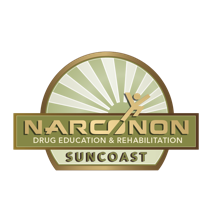Those of us at Suncoast Rehabilitation Center hear various myths about drugs, which – when believed – can really cause harm to the believer. We are doing a series of articles here to expose such myths and get the truth out in the open:
MYTH #1:
Drug addiction is voluntary behavior.

TRUTH:
A person starts out as an occasional drug user, and that is a voluntary decision. Or a person is prescribed a pain killer for a legitimate situation; deciding to take that prescription too is voluntary. But as times passes, something happens, and that person goes from being a voluntary drug user to a compulsive drug user. Why? Long term drug use causes changes within the person’s body:
- The person becomes tolerant to the drug and needs to take more of it to obtain the same effect.
- Certain hormones in the brain that affect pleasure are cut off from the person unless the drug is used. The user actually needs the drug in order to feel pleasure – and sometimes they need the drug to feel anything at all.
These factors can cause physical and/or mental addiction to the drug, which means they feel they must take the drug in order to feel normal.
(The Neurobiology of Drug Addiction (Provided by NIH in Jan 2007). Principles of Addiction Treatment: A Research-Based Guide. (October 1999). National Institute on Drug Abuse, National Institute of Health. (2001).)
MYTH #2:
People don’t need treatment. They can stop using drugs if they really want to.
TRUTH:
It is extremely difficult for people addicted to drugs to achieve and maintain long-term abstinence. Even when the person is making a determined effort to stay off drugs or alcohol, residuals from past use, stored in the body, can generate severe cravings -- pressure from the body to once again take that drug or drink. Further, being around people or places where one did drugs or alcohol can also give rise to a compulsion to use again, which is difficult to resist.
When these residues are released from storage into the blood stream in moments of high stress or exercise, they can cause cravings. This also appears to be why former LSD users can experience ”flash backs” even long after they have ceased to use the drug. The New Life Detoxification procedure delivered as part of the Narconon program removes these residues. Those who have done this part of the program frequently remark on the decrease in intensity of cravings or even their elimination altogether.
(Principles of Addiction Treatment: A Research-Based Guide. (October 1999). National Institute on Drug Abuse, National Institute of Health. (2001), New Life Detoxification Program.)
MYTH #3:
If you’ve tried one doctor or treatment program, you’ve tried them all.
TRUTH:
Not every doctor or program may be the right fit for someone seeking treatment.
It is important that the program address all aspects of addiction. Some, for example, merely get a person off their immediate drug use and count on social support groups to keep the person sober. Others substitute drugs, putting the person on a more “manageable” drug (such as Methadone rather than heroin) but still leaving the person addicted.
The Narconon program not only has a drug-free withdrawal step; it addresses toxic drug residuals with the New Life Detoxification and then, in a series of Life Skill courses, gives the person skills and tools needed for them to be able to chart their own way to a successful and happy -- and drug free life.

If you know someone who is struggling with addiction, or if you are, yourself, please contact us right away. Our phone number is (877) 850-7355, and information about our long-term, inpatient program, how it works, and the stories of our graduates can be found at www.suncoastrehabcenter.com.
